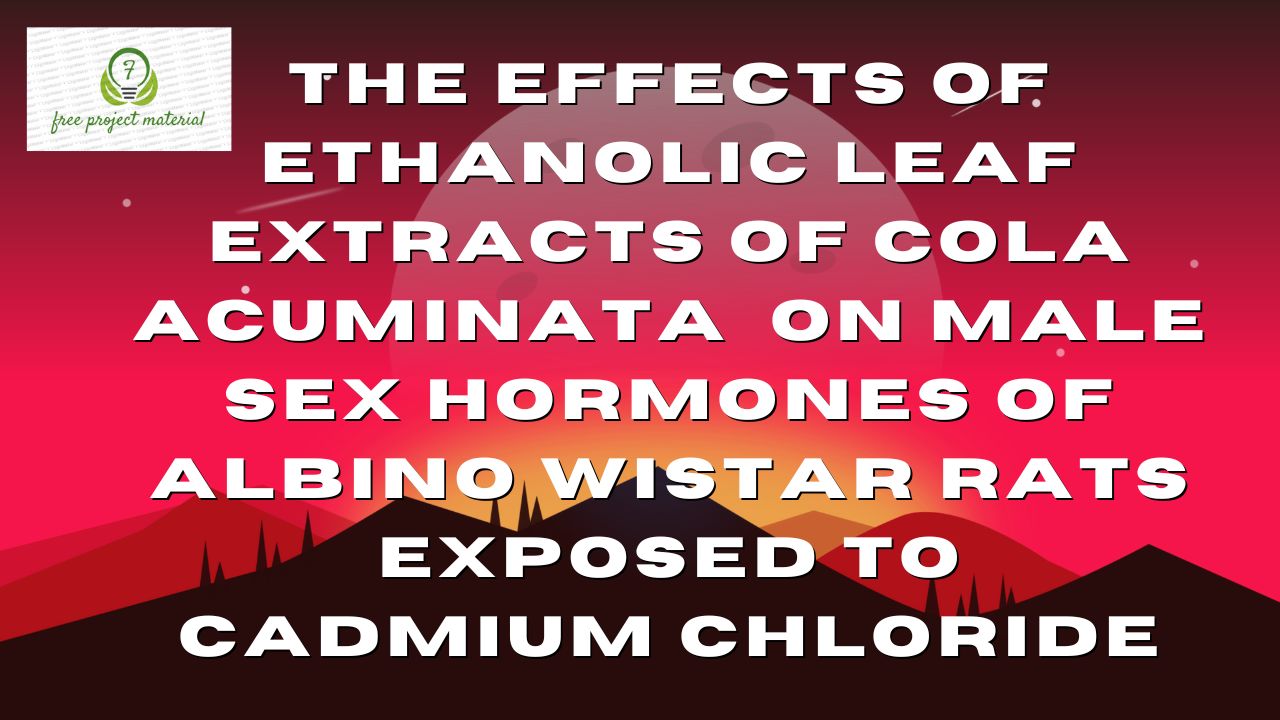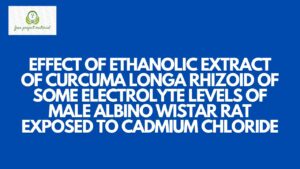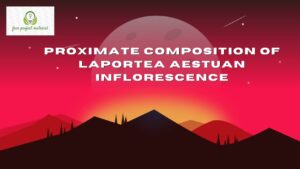ABSTRACT
This study was aimed at investigating the effect of ethanolic leaf extract of Cola acuminata on the male sex hormones of Albino wistar rats exposed to cadmium chloride. Twenty (20) Albino wistar rats were randomly assigned into five (5) groups of four rats each. Group 1 served as the control and was fed with normal rat chow and distilled water. Group 2 was treated with 30% of LD50 of cadmium chloride. Group 3, 4 and 5 were pre-treated with 30% of LD50 of cadmium chloride and then 100mg/kg, 200mg/kg and 300mg/kg body weight of ethanolic leaf extract of Cola acuminata respectively. All the experimental animals were allowed free access to normal rat chow and distilled water throughout the period of the study. The result of the study showed a significant (p0.05) increase in testosterone, LH and FSH in the treatment groups. The cadmium chloride administered resulted in decrease of testosterone, LH and FSH. This suggests that Cola acuminata has the capacity to ameliorate heavy metal – induced infertility.
TABLE OF CONTENT
Title Page – – – – – – – – – – i
Certification – – – – – – – – – ii
Dedication – – – – – – – – – iii
Acknowledgements – – – – – – – – iv
Abstracts – – – – – – – – – – v
Table of Contents – – – – – – – – vi
CHAPTER ONE: INTRODUCTION
- Background of the Study – – – – – – 1
- Aim and Objectives of the Study – – – – 4
- Scope and Limitation of the Study – – – – – 5
CHAPTER TWO: LITERATURE REVIEW
2.1 Use of Cola acuminata in Ethnomedicine – – – 6
2.2 Phytochemistry of Cola acuminata – – – – – 7
2.3 Pharmacological Effect of Cola acuminata – – – – 9
2.3.1 Anti-Cancer Potential – – – – – – – 9
2.3.2 Anti-Microbial- – – – – – – – 10
2.3.3 Other Biological Activity of Cola acuminate – – – 12
2.4 Mechanism of Cadmium toxicity – – – – – 13
2.5 Clinical manifestation of Cadmium acuminate – – – 15
2.5.1 Renal Damage in Cadmium Toxicity – – – – – 15
2.5.2 Cadmium and Reproductive System – – – – – 16
2.5.3 Cadmium and Cardivascular System – – – – – 17
2.6 Treatment of Cadmium Toxicity – – – – – 18
2.7 Male Sex Hormones – – – – – – – 20
2.7.1 Testosterone – – – – – – – – 20
2.7.2 Follicle Stimulating Hormone – – – – – – 23
2.7.3 Leitinizing Hormone – – – – – – – 26
CHAPTER THREE: MATERIALS AND METHODS
3.1 Materials – – – – – – – – – 30
3.1.2 Preparation of Reagent Used – – – – – – 30
3.2 Methods – — – – – – – – – 31
3.2.1 Collection of plant Sample – – – – – – 31
3.2.2 Preparation of Plant Sample – – – – – – 31
3.2.3 Experimental Design and Treatment – – – – – 32
3.2.4 Collection of Blood Sample and preservation of serum – – 34
3.2.5 Determination of parameters.(testosterone, FSH and LH) – 35
3.3 Statistical Analysis – – – – – – – 38
CHAPTER FOUR: RESULTS AND DISCUSSON
4.1 Results – – – – – – – – – 39
4.2 Discussion – – – – – – – – – 40
CHAPTER FIVE: CONCLUSION AND RECOMMENDATION
5.1 Conclusion – – – – – – – – – 44
5.2 Recommendation – – – – – – – – 44
References
CHAPTER ONE: INTRODUCTION
1.1 Background of the study
Kolanut is the fruit of the cola species and belongs to the family of Sterculiacaea (Sonibare, et al 2009). In Nigeria, varieties of kola nut are Cola acuminata (C. acuminata) Cola nitida, and Garcinia cola (Adeniyi and Akinnuoye 2017).Cola acuminate has high ceremonial values among the Igbos and Yorubas in Nigeria. Kolanut has a bitter taste when chewed and contains caffeine (Adeniyi and Akinnuoge, 2017). However kola nut possesses medicinal and pharmacological values (Adebayo and Oladece 2012). It is used for the treatment of whooping cough, malaria, fever asthma and acts as a bronchodilator because of cattcine (Jayeola et al., 2001). Also, kola nuts have antimicrobial analgesic and lipolytic properties and can stimulate gastric juice secretion as well. Traditionally, the leaves, bark, fruit follicles and flowers are used in the treatment of dysentery, diarrhea, coughs, vomiting and chest complaints (Bukola, 2018).
Kola nuts have been linked with natural fertility regulation. Infertility is defined as the inability to achieve pregnancy after 12 months or more of unprotected sexual intercourse (Techier, 2019) which is a primary reproduction health concern in Nigeria, and women usually bear the blame. Most cases of infertility in Nigeria and Africa are due to infection (Akenloye, 2011). In males, causes of infertility are namely; obstruction of the seminal tract, sexual disorder, inflammation, nutritional deficiencies, prolonged exposure to chemical, excessive heat, heavy metals, hormonal imbalance, lifestyle, abnormal sperm count or quality and interference with spermatogenesis (Mahat and Sharma, 2017). Low levels of plasma estrogen are among hormonal disturbance as that may lead to infertility (Halim, et al., 2010).
Environmental estrogenic agents such as phytoestrogen diets may reduce male fertility by disrupting the normal hormonal balance in the body.(Cederroth et al., 2010). Some studies have validated the use of plants either to enhance sexual desire or to improve spermatogenesis (Techier, 2019)
Many herbs used in the traditional remedies to treat male infertility include
Alframomum meleyueta, Boerhavia diffusa, Momordica charantia, Sphenocetum folyanum, Telefaira occidentalis, Phyllanthus amarus, Irvingia gabonensis, Landolthia dulci, Allium cepa and Cissus populnea (Okoli et al., 2007).
Epidemiology: In spite of the dramatic worldwide production, consumption and release of cadmium compounds in the environment show no efficient recycling way for them. Human exposure to cadmium compound may create a serious health problem. Cadmium has been used in nickel-cadmium battery, as a pigment in paint production likewise, in electroplating and producing polyvinyl chloride plastic. Furthermore, cadmium is present in most food stuffs, and depending on dietary habits, its level varies greatly.
Cadmium considerably exists in environment as a result of human activities such as the use of fossil fuels, metal ore combustion and waste burning. Leaking sewage sludge to agricultural soil may cause the transfer of cadmium compounds adsorbed by plants that may play a significant role in food chain, and accumulate in various humans organs.
Another great source of cadmium exposure is cigarette smoke. When cadmium was measured in smoker’s blood samples, it showed that they had 4-5 times cadmium levels in blood higher than the non-smokers (Munisamy, 2013).
Exposure to cadmium in many different ways has been reported, the number of patients affected by exposure of cadmium since 1990 to 2004 in up to 400 (Kaji 2012).
1.2 Aim And Objectives of the Study
1.2.1 Aim
The aim of this study is to evaluate the effect of ethanolic leaf extract of Cola acuminata on male sex hormones of Albino wistar rats expose to cadmium chloride.
1.2.2 Objectives
The objectives of this study are to examine;
The effect of Cola acuminata leaf extract on the testosterone level of Albion wistar rats treated with cadmium chloride
The effect of Cola acuminata leaf extract on the testosterone level of Albino wistar rats .
The effect of Cola acuminata leaf extract on the Follicle stimulating hormone level of Albino wistar rats.
The effect of Cola acuminata leaf extract on the luteinizing Hormone level of Albino wistar rats.
To make useful recommendation based on the findings and results
1.3 Scope and Limitation of the Study
This study focuses on the effect of ethanolic level extract of Cola acuminata on male sex hormones only duce to time and financial constraint.



